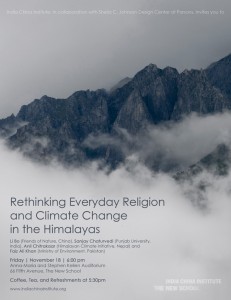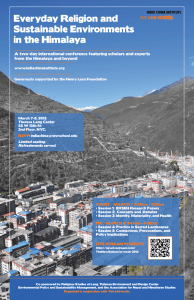Everyday Religion and Sustainable Environments in the Himalaya, 2010-2013
Everyday Religion and Sustainable Environments in the Himalaya (ERSEH) was a multi-year initiative aimed at expanding understandings of the relationship between local religious beliefs and practices and sustainable environment policies. The projects created opportunities for knowledge sharing and scholarship on the complex role religion plays regarding environmental protection.
Knowledge generated by the initiative’s projects went beyond the academic enterprise to a general audience, and contributed to the ability of individuals, institutions, and communities in the Himalaya region to engage and address contemporary issues of sustainable environmental policy-making. Findings from fieldwork and applied research from the project were disseminated through published reports, public programs and international conferences in the United States, India, China, and other countries in the region.
Given the diversity of traditions and practices within the region, the Himalaya was an ideal laboratory and a focal point for a discussion on the intersection of climate change and local culture. The social life and cultural beliefs of the affected local Himalayan population were understood to be a critical factor in local conception and development of effective environmental policies aimed at sustainability.
One of the key features of the ERSEH initiative was that everyday religion, which is shaped by diverse socio-cultural beliefs, values, and ritual practices, was understood as a feature of local understanding of environmental sustainability. ERSEH drew on a holistic framework in scholarly research known as “lived religion.” This epistemological approach can be compared to what in past scholarship was thought to be the exclusive domain of religious specialists–that of prophets, priests, shamans, and monks. The study of lived religion involves seeing ordinary people as religious actors, and understanding how they integrate the many concerns of their lives and those of their communities into a set of beliefs, and into spiritual and religious practices.
The success of ERSEH led to the launch of a second multi-year initiative expanding this focus on religion and ecology in the Himalaya, the Sacred Himalaya Initiative.



